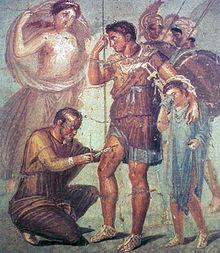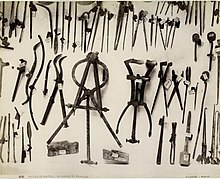Medicine in ancient Rome
This section needs additional citations for verification. (June 2008) |
It has been suggested that this article be merged with Medical community of ancient Rome and Talk:Medicine in ancient Rome#Merger proposal. (Discuss) Proposed since May 2008. |
Ancient Roman medicine combined various techniques using different tools and rituals. Ancient Roman Medicine included a number of specializations such as intemistic, ophthalmology and urology. Romans believed in supernatural causes for many diseases and in some supernatural cures (see bottom of article). The Romans favoured the prevention of diseases over the cures of them; unlike in Greek society where health was a personal matter, Public health was encouraged by the government at the time; they built bath houses and aqueducts to pipe water to the cities. Many of the larger cities, such as Rome, boasted an advanced sewage system, the likes of which would not be seen in the Western world again until the late 17th and 18th centuries. They also did not fully understand that germs were related to diseases.

Roman surgeons carried a tool kit which contained forceps, scalpels, catheters and arrow extractors. The tools had various uses and were boiled in hot water before each use. In surgery, surgeons used painkillers such as opium and scopolamine for treatments and acetum (the acid in vinegar) was used to wash wounds. Romans didn't believe in the supernatural as much as the Greeks; the Greeks used temples and religious belief to try and cure someone, yet the Romans developed specific hospitals which enabled the patients to be fully rested and relaxed so they could completely recover. By staying in the hospitals, the doctors (which now had different levels of qualification) were able to observe the illness rather than rely on the supernatural to cure him/her.
Greek Influences on Roman Medicine
Many Greek medical ideas were adopted by the Romans and Greek medicine had a huge influence on Roman medicine. The first doctors to appear in Rome were Greek, captured as prisoners of war. Greek doctors would later move to Rome because they could make a good living there, or a better one than in the Greek cities.
The Romans also conquered the city of Alexandria, its libraries and its universities. In Ancient times Alexandria was an important centre for learning and its Great Library held countless volumes of information, many of which would have been on medicine. Here, doctors were allowed to carry out dissections which led to the discovery of many important medical advances, such as the discovery that the brain sends messages to the body.
Greek Medicine revolved heavily around the theory of the Four Humours and texts by Hippocrates and his followers (Hippocratic Writings), who were all Greek. These ideas and writings were also used in Roman medicine.
Roman Medicine also encompassed the spiritual beliefs of the Greeks (see below).
Dioscorides
Pedanius Dioscorides (ca. 40-ca. 90) was an ancient Greek physician, pharmacologist and botanist from Anazarbus, Cilicia, Asia Minor, who practised in ancient Rome during the time of Nero. Dioscorides is famous for writing a five volume book De Materia Medica that is a precursor to all modern pharmacopeias, and is one of the most influential herbal books in history.
Soranus
Soranus was a Greek physician, born at Ephesus, who lived during the reigns of Trajan and Hadrian (AD 98-138). According to the Suda, he practised in Alexandria and subsequently in Rome. He was the chief representative of the school of physicians known as "Methodists." His treatise Gynaecology is extant (first published in 1838, later by V. Rose, in 1882, with a 6th-century Latin translation by Muscio, a physician of the same school).
Galen
Galen (AD 129[1] –ca. 200 or 216) of Pergamon was a prominent ancient Greek[2] physician, whose theories dominated Western medical science for well over a millennium. By the age of 20, he had served for four years in the local temple as a therapeutes ("attendant" or "associate") of the god Asclepius. Although Galen studied the human body, dissection of human corpses was against Roman law, so instead he used pigs, apes, and other animals. Galen moved to Rome in 162. There he lectured, wrote extensively, and performed public demonstrations of his anatomical knowledge. He soon gained a reputation as an experienced physician, attracting to his practice a large number of clients. Among them was the consul Flavius Boethius, who introduced him to the imperial court, where he became a physician to Emperor Marcus Aurelius. Despite being a member of the court, Galen reputedly shunned Latin, preferring to speak and write in his native Greek, a tongue that was actually quite popular in Rome. He would go on to treat Roman luminaries such as Lucius Verus, Commodus, and Septimius Severus. However, in 166 Galen returned to Pergamon again, where he lived until he went back to Rome for good in 169.
Surgical instruments

Romans invented numerous surgical instruments, including the first instruments unique to women,[3] as well as the surgical uses of forceps, scalpel, cautery, cross-bladed scissors, surgical needle, sound, and specula.[4][5] Romans were also pioneers in the cataract surgery.[6].
Other medical instruments used in ancient Rome:
Bone hooks: These instruments were long and thin and were mostly used for maneuvering tissue. The Greeks also used this tool. The hooks came in two varieties: sharp and blunt. Sharp hooks were used to remove tissue from wounds and blunt hooks were used for dissections.
Bone drills: Picture a wine cork screw. This is what a bone drill looked like. Bone drills were used to remove diseased bone tissue from the skull or to remove any foreign object(s). Similar tools had been used by Prehistoric Man to remove evil spirits.
Spatula: This instrument was used to mix and apply various ointments to patients.
Probe: This instrument was used to carefully examine a wound before treatment.
Surgical saw: This instrument was used to cut through bones in amputations and surgeries.
Catheter: Used to cause urination. It would was likely far more uncomfortable than modern catheters due to the fact that Roman catheters were made of some sort of metal such as bronze.
Medicines

Medicinal herbs
Some Ancient Roman herbs used in medicine were:
Fennel: It was thought to have calming properties
Elecampane: Used to help with digestion
Sage: Although it had little medicinal value, they had great religious value.
Garlic: Beneficial for health, particularly of the heart
Fenugreek: Used in the treatment of pneumonia
Mustard
Silphium: Used for a wide variety of ailments and conditions--especially for birth control.
Asclepieions in Roman Medicine
When the Roman Army conquered Greece they adopted many of their medicinal beliefs and ideas. The cult of Asclepios had spread across much of Greece and numerous temples (asclepieions) had been built in his name. These Asclepieions (or Asklepieions) were places of healing. They contained baths, gardens and other facilities designed to improve people's health. People who were being treated in the Asclepieions would sleep in front of a statue of the Greek God in the hope that he would heal them in their sleep. Though several accounts have been recovered, detailing the progress in health made by people admitted to the Asclepieions, it is unlikely that they were based on fact; they may simply have been used as propaganda.
Tiber Island
Tiber Island in Rome was once the location of an ancient temple to Aesculapius, the Greek god of medicine and healing.
Accounts say that in 293 BC, there was a great plague in Rome. Upon consulting the Sibyl, the Roman Senate decided to build a temple to Aesculapius, the Greek god of healing, and sent a delegation to Epidauros to obtain a statue of the deity. They obtained a snake from a temple and put in on board their ship. It immediately curled itself around the ship's mast and this was deemed as a good sign by them. Upon their return up the Tiber river, the snake slithered off the ship and swam onto the island. They believed that this was a sign from Aesculapius, a sign which meant that he wanted his temple to be built on that island.
References
- ^ "Galen". Encyclopædia Britannica. Vol. IV. Encyclopædia Britannica, Inc. 1984. pp. p. 385.
{{cite encyclopedia}}:|pages=has extra text (help) - ^ Galen of Pergamum
- ^ Surgical Instruments from Ancient Rome
- ^ Roman period surgery set on show, BBC
- ^ Chirurgia, William Alexander Greenhill, M.D., Trinity College, Oxford
- ^ The Romans carried out cataract ops, BBC
- This article incorporates text from a publication now in the public domain: Chisholm, Hugh, ed. (1911). Encyclopædia Britannica (11th ed.). Cambridge University Press.
{{cite encyclopedia}}: Missing or empty|title=(help)
